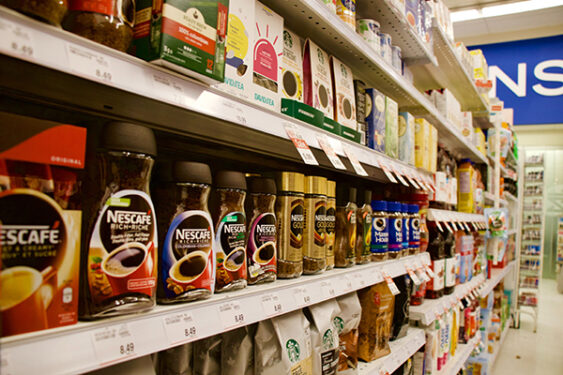
Mother of five: ‘How are people supposed to survive?’
PROSPECT HEIGHTS — Jennifer Uzzi-Silverio sighs and takes a deep breath every time she goes food shopping for her family.
Uzzi-Silverio, a former teacher who works for a Catholic teacher’s union, not only has to continuously stretch her dollars at the supermarket, she has cut back on certain food items for herself to ensure that her two sons, James, 17, and Jackson, 10, have enough.
“My sons aren’t big milk drinkers, But I am,” she said, explaining that she suffers from a kidney condition that necessitates her consuming dairy products to bind the proteins in her system to avoid developing kidney stones. Yet, she often goes without. “I don’t buy milk like I used to because it’s very, very expensive,” she added.
The last time she was at her local Stop & Shop, she paid $4.59 for a gallon of Fairlife lactose-free milk — significantly more than she paid last year when the price hovered around $4.00.
And it’s all because the dollar doesn’t go as far as it used to. In the face of rising inflation, millions of parents across the country like Uzzi-Silverio are being forced to either dig a lot deeper into their wallets or drastically reduce the amount of food they buy.
According to the Consumer Price Index (CPI), at-home food prices (groceries, not take-out or restaurant fare) increased 10.8% between April 2021 and April of this year. It was the largest one-year jump in food prices since 1980-1981.
The CPI revealed that overall inflation in the U.S. rose 8.5% between 2021 and this year, the fastest rate in 39 years,
Staples like milk, bread, eggs, and butter are pricier, and buying in bulk at big box stores doesn’t bring the costs down.
“I usually shop in local stores like ShopRite or Stop & Shop. But occasionally I’ll go to BJs or Costco and the prices are just as high,” said Uzzi-Silverio, who lives in Lower Manhattan. “You might be getting a bigger quantity of food but it’s still at a higher price. The prices are going up ridiculously — not to mention the amount of money that it costs to put gas in your tank just to get to the store.”
And there doesn’t seem to be any relief in sight. According to a May 25 USDA report, food-at-home prices are predicted to increase between 7% and 8%, and food-away-from-home prices are predicted to increase between 6% and 7% throughout the year.
Nicholas Freudenberg, a senior faculty fellow at the Urban Food Policy Institute of the City University of New York, said the type of food inflation today’s consumers are experiencing is due to several factors, including supply chain interruptions brought about by the pandemic.
“The pandemic profoundly disrupted all forms of trade and commerce and with disruptions to shipping supply chains, there were a whole variety of food items that were hard to get to the right place at the right time. With less supply and more demand, prices go up,” he explained.
Another factor Freudenberg cited is the Russia-Ukraine war.
“Both Ukraine and Russia are primary suppliers of wheat and other grains for the world,” Freudenberg explained. “With Russia preventing Ukraine from shipping food out and Russia’s food production being disrupted by the war, it has reverberations around the world, including raising prices here in the United States.”
There are other factors that cause higher prices.
“I think it was compounded by the fact that the food system in the United States is highly concentrated. Those giant food companies have monopoly power to set prices and in the aftermath of the pandemic, giant companies … took the opportunity to use that monopoly power to raise prices to increase their profits,” he said.
Yaneris Carbone, a property manager who lives in Richmond Hill, does most of her food shopping online. She estimated that she pays $400 a week for groceries for her family, including herself, her husband, their two sons, and a niece who lives with them. In 2021, her average grocery bill each week was $250.
“How are people supposed to survive? Everything’s going up except salaries,” she said.
She was recently buying eggs when she was struck by sticker shock. “I usually buy organic eggs. So yes, they are a little pricier than regular eggs. But I noticed this year how much more they were. And I said to myself, ‘I cannot believe what I’m paying!’ I paid for it, but it was painful,” she recalled.
Carbone hasn’t cut back on her grocery purchases but inflation has caused her family to reduce discretionary spending. “We don’t go out to restaurants much. We mostly eat at home,” she said.
Still, certain household expenses are non-negotiable, like her children’s Catholic education. Her two sons, Joseph, 10, and Andrew, 7, attend Holy Child Jesus Catholic Academy in Richmond Hill.
Similarly, Uzzi-Silverio is committed to providing her sons with a Catholic education. James attends LaSalle Academy in Manhattan. Jackson is a student at St. Peter Catholic Academy in Bensonhurst.
St. Peter’s offers free breakfast and lunch to students, thanks to a grant. Uzzi-Silverio is grateful for that, partly because it saves her from paying for her son’s lunch. She also finds ways to stretch her dollar by buying slightly overripe fruit at a discount. She puts the fruit in her freezer at home for her sons to use when they make smoothies.
